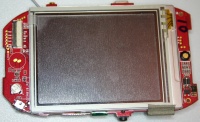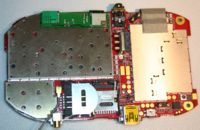Introduction
From Openmoko
m (→Phones) |
|||
| (85 intermediate revisions by 31 users not shown) | |||
| Line 1: | Line 1: | ||
| − | + | {{Languages|Introduction}} | |
| − | + | Openmoko is a project to create mobile phones with an open software stack. | |
| − | + | ||
| − | + | ||
| − | + | '''Openmoko Inc releases hardware''': phones to run the open source software stack. The first phone was the [[Neo 1973]], followed by the current model, [[Neo FreeRunner]]. Users may freely choose to run another operating system on their Openmoko smartphone -- please see [[Distributions]] to learn more. | |
| − | + | ||
| − | + | ||
| − | + | ||
| − | + | '''Openmoko Inc releases software''': the operating system and applications for the Openmoko phones. The current software stack is the [[Om 2008.12]]. Newly purchased Neo FreeRunners, however, still ship with the older stack [[Om 2007.2]]. Openmoko runs on all kinds of [[Supported Hardware|Linux-capable mobile phones]] or in an [[Openmoko_under_QEMU|emulator]]. | |
| − | + | ||
| − | + | ||
| − | + | ||
| − | + | ||
| − | + | ||
| − | + | ||
| − | + | '''Free Your Phone''' mission allows users to customize the phone platform to their needs, modify existing software, and create or install any additional software. With [http://www.freesmartphone.org freesmartphone.org], Openmoko is working on a stable system services software back-end; freesmartphone.org is a collaboration platform for open source and open discussion software projects working on interoperability and shared technology for Linux-based smartphones. This [[OpenmokoFramework]] will be used in forthcoming Openmoko distributions. | |
| − | + | ||
| − | + | ||
| − | + | ||
| − | + | The - base of the Openmoko software stack - | |
| − | + | The Openmoko project has been initiated by [http://www.fic.com.tw/ FIC Inc] and [http://www.openmoko.com Openmoko, Inc.] | |
| − | + | ||
| − | + | ||
| − | + | ||
| − | + | ||
| − | + | ||
| − | + | The Openmoko stack, which includes a full X server, allows users and developers to transform mobile hardware platforms into unique products. Our license gives developers and users freedom to cosmetically customize their device or radically remix it; change the wallpaper or rebuild the entire house! It grants them the freedom, for example, to transform a phone into a medical device or point of sale device or the freedom to simply install their own favorite software. Beyond freeing the software on our devices we have also released our [http://downloads.openmoko.org/developer/CAD/ CAD] files. And at LinuxWorld 2008, we announced the release of the [http://downloads.openmoko.org/developer/schematics/ schematics for our products]. | |
| − | + | ||
| − | + | ||
| − | + | ||
| − | |||
| − | |||
| − | |||
| − | + | == Phones == | |
| − | + | ||
| − | + | ||
| − | + | ||
| − | + | ||
| − | + | ||
| − | + | {| | |
| − | + | | [[Image:GTA02.gif|170px]] || [[Image:FIC-neo1973_small.jpg|200px]] | |
| − | + | |- | |
| − | + | | [[Neo FreeRunner]] || [[Neo 1973]] | |
| − | + | |} | |
| − | + | ||
| − | + | ||
| − | + | == Software == | |
| − | + | ||
| − | + | ||
| − | + | {| | |
| − | + | | [[Image:Om2008 home.png|200px]] || [[Image:Main.png|200px]] | |
| − | + | |} | |
| − | + | [[Om 2008.12]] distribution screenshots. | |
| − | == | + | == Videos == |
| + | * [http://www.youtube.com/watch?v=jRvtAAXTIlg World Debut: The First Completely Open Mobile Phone] Interview with Sean Moss Pultz. | ||
| + | * [http://video.google.co.uk/videoplay?docid=-3742589179435830945&hl=en-GB Talk about Openmoko by Sean Moss Pultz at FOSdem] on 23rd Feb 2007. [http://rapidshare.com/files/18781887/rect.avi High resolution version] with the screen zoomed and transformed to the projector screen, text readable. | ||
| + | * [http://video.google.com/videoplay?docid=-8574715471341709984 Openmoko at Tossug], Presented by Sean Moss Pultz and Harald Welte at Taipei Open Source Software User Group (TOSSUG) | ||
| + | * [http://www.youtube.com/watch?v=hn7wuxlTNvs TangoGPS] presentation. | ||
| − | == | + | == See also == |
| − | + | ||
| − | [[ | + | * [http://lists.openmoko.org/pipermail/announce/2007-January/000000.html Openmoko announcement] |
| − | [[ | + | * [http://blog.printf.net/articles/2007/02/22/unboxing-the-openmoko-phone Neo 1973 in operation to see screen clarity] |
| + | * [http://www.youtube.com/user/mokoNinja mokoNinja's videos on YouTube] | ||
| + | |||
| + | [[Category:Openmoko Inc| ]] | ||
Latest revision as of 03:25, 5 May 2010
| Languages: |
English • العربية • Български • Česky • Dansk • Deutsch • Esperanto • Eesti • Español • فارسی • Suomi • Français • עברית • Magyar • Italiano • 한국어 • Nederlands • Norsk (bokmål) • Polski • Português • Română • Русский • Svenska • Slovenčina • Українська • 中文(中国大陆) • 中文(台灣) • Euskara • Català |
Openmoko is a project to create mobile phones with an open software stack.
Openmoko Inc releases hardware: phones to run the open source software stack. The first phone was the Neo 1973, followed by the current model, Neo FreeRunner. Users may freely choose to run another operating system on their Openmoko smartphone -- please see Distributions to learn more.
Openmoko Inc releases software: the operating system and applications for the Openmoko phones. The current software stack is the Om 2008.12. Newly purchased Neo FreeRunners, however, still ship with the older stack Om 2007.2. Openmoko runs on all kinds of Linux-capable mobile phones or in an emulator.
Free Your Phone mission allows users to customize the phone platform to their needs, modify existing software, and create or install any additional software. With freesmartphone.org, Openmoko is working on a stable system services software back-end; freesmartphone.org is a collaboration platform for open source and open discussion software projects working on interoperability and shared technology for Linux-based smartphones. This OpenmokoFramework will be used in forthcoming Openmoko distributions.
The - base of the Openmoko software stack - The Openmoko project has been initiated by FIC Inc and Openmoko, Inc.
The Openmoko stack, which includes a full X server, allows users and developers to transform mobile hardware platforms into unique products. Our license gives developers and users freedom to cosmetically customize their device or radically remix it; change the wallpaper or rebuild the entire house! It grants them the freedom, for example, to transform a phone into a medical device or point of sale device or the freedom to simply install their own favorite software. Beyond freeing the software on our devices we have also released our CAD files. And at LinuxWorld 2008, we announced the release of the schematics for our products.
Contents |
[edit] Phones
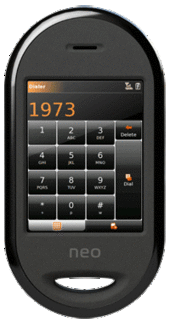 |
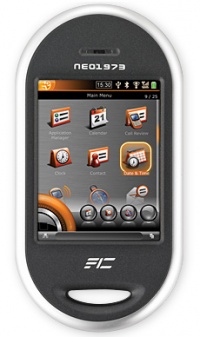
|
| Neo FreeRunner | Neo 1973 |
[edit] Software
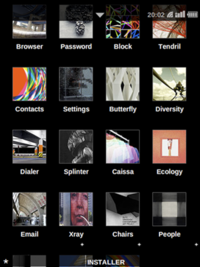 |
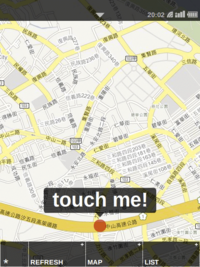
|
Om 2008.12 distribution screenshots.
[edit] Videos
- World Debut: The First Completely Open Mobile Phone Interview with Sean Moss Pultz.
- Talk about Openmoko by Sean Moss Pultz at FOSdem on 23rd Feb 2007. High resolution version with the screen zoomed and transformed to the projector screen, text readable.
- Openmoko at Tossug, Presented by Sean Moss Pultz and Harald Welte at Taipei Open Source Software User Group (TOSSUG)
- TangoGPS presentation.

